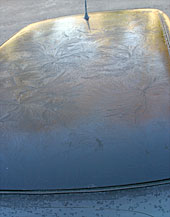Fern frost, so named for its leafy fern like swathes, is best seen after a cold night on old single-glazed window panes. They are now hard to come by but car windscreens and external bodywork make fine substitutes.
The frost formation starts when the surface cools below that of the surrounding air temperature by radiating its heat out to the empty night sky. Water molecules from the air condense onto rough (at an atomic level) nuclei – scratches, pits, dust particles. Once a tiny ice crystal has formed it spreads across the cold surface. Crystal growth is fastest at edges rather than on the large smooth planes of facets. We see large single crystal shapes when the initial growth nuclei are far apart. (Almost) clean cars make the best patterns
The growth is dendritic, treelike, along the hexagonal crystal directions to give the characteristic ribbed and branched appearance. The complex but overall symmetric shapes of snowflakes are similarly produced.
|











